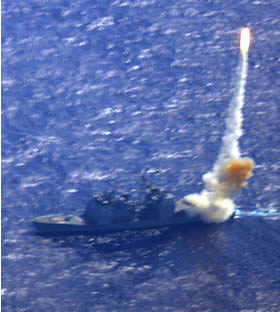In a first-of-its-kind dual missile defense test yesterday, Aegis Ballistic Missile Defense (BMD) cruiser USS Lake Erie (CG 70) demonstrated simultaneous ship engagements against both cruise and ballistic missile targets. The interceptors included an SM-3 Block IA missile, which destroyed a short-range ballistic missile target in space while an SM-2 Block IIIA engaged a cruise missile threat at a lower altitude. Both missiles are produced by Raytheon Company (NYSE:RTN).
 The test marked the eighth successful intercept in ten flight tests for the Aegis Ballistic Missile Defense (BMD) Program, and the 27th successful hit to kill intercept in tests since 2001.
The test marked the eighth successful intercept in ten flight tests for the Aegis Ballistic Missile Defense (BMD) Program, and the 27th successful hit to kill intercept in tests since 2001.
It also marked the first flight test of all the SM-3 Block IA’s upgrades, previously demonstrated only in ground tests; it also demonstrated the effectiveness of engineering, manufacturing, and mission assurance changes in the solid divert and attitude control system (SDACS) in the kinetic kill weapon.
The engagement started on 11:31 a.m. Hawaii Time, when a short-range ballistic missile target was launched from the Pacific Missile Range Facility (PMRF) in Hawaii. At the same time, a target simulating a hostile high performance aircraft or cruise missile was launched from a Navy aircraft. The Aegis cruiser, equipped with the Ballistic Missile Defense 3.6 Weapon System, detected and tracked both targets and developed fire control solutions. Approximately one minute later, the Lake Erie’s crew fired the SM-3 and SM-2 missiles.
 The missiles received continuous updates on the target’s location during their flight, enabling the third stage to shape its flight profile to narrow the intercept envelope before handing off terminal guidance to the kinetic warhead (KW). On the terminal phase, the KW commanded the SDACS to perform a series of maneuvers to keep the SM-3 on target all the way to a lethal intercept. Two minutes after launch both missiles successfully intercepted their respective targets. The SM-3 intercept occurred approximately 100 miles above the Pacific Ocean and 250 miles northwest of Kauai, through a “hit to kill” direct impact with the target.
The missiles received continuous updates on the target’s location during their flight, enabling the third stage to shape its flight profile to narrow the intercept envelope before handing off terminal guidance to the kinetic warhead (KW). On the terminal phase, the KW commanded the SDACS to perform a series of maneuvers to keep the SM-3 on target all the way to a lethal intercept. Two minutes after launch both missiles successfully intercepted their respective targets. The SM-3 intercept occurred approximately 100 miles above the Pacific Ocean and 250 miles northwest of Kauai, through a “hit to kill” direct impact with the target.
The test, designated Flight Test Mission-11, was the second with the Block IA version of SM-3 and the first IA with a full-capability solid divert and attitude control system. (SDACS). This system maneuvers the kinetic warhead (KW) to the target using multiple pulses of gas generated by the SDACS propellant. Boeing (NYSE: BA) builds several components of the KW, including the guidance electronics, which it integrates with the Raytheon infrared seeker. Alliant Techsystems (NYSE:ATK) is providing the Third Stage Rocket Motor (TSRM) and the Solid Divert and Attitude Control System (SDACS) the missile’s kill vehicle.
The Aegis BMD 3.6 Weapon System, including the SM-3 Block IA missile, was certified for tactical deployment by the U.S. Navy and MDA in September 2006. Aegis BMD 3.6 enhances the ballistic missile defense capabilities of the current Aegis BMD fleet and adds capability in other warfare areas – as demonstrated in today’s test. An earlier version of Aegis BMD was declared operational in October 2004. Currently, seven Aegis-equipped warships have the ability to engage ballistic missiles. Another nine Aegis warships are equipped with Aegis BMD Long Range Search &Track capability. Japan began installation of Aegis BMD in its Kongo-class Aegis destroyers in 2007.
 The SM-3 Block IA provides increased capability to engage short- to intermediate-range ballistic missiles. The SM-3 Block IA incorporates rocket motor upgrades and computer program modifications to improve sensor performance, missile guidance and control, and lower cost.
The SM-3 Block IA provides increased capability to engage short- to intermediate-range ballistic missiles. The SM-3 Block IA incorporates rocket motor upgrades and computer program modifications to improve sensor performance, missile guidance and control, and lower cost.
The Missile Defense Agency (MDA) and the U.S. Navy are jointly developing Aegis BMD as part of the US Ballistic Missile Defense System (BMDS). Ultimately 15 Aegis destroyers and three Aegis cruisers will be outfitted with the ability to engage short to intermediate range ballistic missile threats and support other BMDS engagements using the Aegis BMD Weapon System and the SM-3. Japan has purchased Aegis BMD capability for their Aegis destroyers and is a partner developing a larger, faster variant of the SM-3.

















